Singapore, 28 October 2023 – Is coastal protection only about building seawalls, or are there more imaginative methods to reshape Singapore’s coastline as we address the threat of rising sea levels and enhance flood resiliency? Youths rose to the challenge in “Living with the Rising Seas”, an ideas competition organised by national water agency PUB to encourage students to propose innovative coastal protection ideas and design concepts.
2. A lush coastal promenade teeming with greenery and recreational spaces. Living seawalls complemented with biodiversity enhancement tiles and tidal pools to promote ecological biodiversity. These were some of the creative proposals received for the competition which was launched in February 2023. Students were given a choice of three coastal typologies – Urban Promenade, Nature-centred Coastline and Recreational Seafront – to showcase their ideas and interpretation of how coastal protection may look like when applied to a particular stretch along Singapore’s south-eastern coastline.
3. More than 110 students from eight local tertiary institutes – the Nanyang Academy of Fine Arts (NAFA), Ngee Ann Polytechnic (NP), National Technological University (NTU), National University of Singapore (NUS), Nanyang Polytechnic (NYP), Singapore Institute of Technology (SIT) Singapore Polytechnic (SP), and Singapore University of Technology and Design (SUTD) took part in the competition, which garnered a total of 32 entries. The students from the schools of engineering, urban planning, sustainable design and landscape architecture represent the diverse expertise required to address our multi-faceted challenges and opportunities in coastal protection.
4. PUB awarded a total of nine winners – three each for the three typologies (described below). A multi-agency panel from PUB, the Urban Redevelopment Authority (URA), National Parks Board (NParks) and PUB’s consultant for the City-East Coast site-specific study assessed the proposals. The competition provided a platform for cross-domain teams to work together. For instance, a winning team from NUS comprised members from different disciplines including integrated sustainable design and green finance.
| Typology | Description |
|---|---|
| A. Urban Promenade | Signature promenade lined with attractive commercial and residential developments, as part of a mixed-use urban precinct. |
| B. Nature-centred Coastline |
Rustic coastline featuring nature and greenery. |
| C. Recreational Seafront |
Accessible waterfront public space for leisure, bringing people closer to water. |
Envision our coastlines in new and innovative ways
5. The winning entries demonstrated creativity in developing integrated solutions for coastal protection, while retaining distinct characteristics of the south-eastern coast. The proposals contained a high level of detail and broad range of considerations, including scope for potential future developments. At the same time, they presented inspirations to reimagine the coast and create multi-functional spaces that adds value to the people and nature.
6. An entry from NAFA, “Woven Hill”, proposed a coastal promenade that seamlessly integrates with Marina South, injecting vibrancy into the area and offering intimate spaces that provide respite from city life through discovery and relaxation. The promenade is augmented by dikes to elevate and protect the site from coastal flooding, as well as the addition of coastal boardwalks, cycling paths, and viewing decks that enhance connectivity between iconic landmarks such as Marina Bay Sands and Gardens by the Bay, and tourism nodes like Marina South Pier.
7. Another entry from NTU, “Trifoliate Horizon”, adopted innovative strategies to conserve our natural heritage and bring residents closer to nature while protecting our coastlines at Labrador Park. In addition to preserving the existing rocky shore, there are natural elements incorporated into its coastal protection measures such as a curved sloping seawall that encourages coral colonisation to act as a natural barrier to attenuate waves.
8. To protect and enhance the recreational seafront, an entry from NUS proposed a coastal defence strategy called “Island Chain”. The proposal dovetails with the conceptual long-term plans for the area and involves building islands combined with seawalls along the East Coast. These islands not only serve as a defence against coastal flooding, but also provide a new waterfront for recreational use. In addition, the basements of these islands can be used for other functions to maximise the use of available space.
9. Mr Atharv Raj Manwani, a member of the “Island Chain” team who is pursuing a Master of Science in Integrated Sustainable Design at NUS, shared: “Our decision to participate in the competition stemmed from a commitment to address the challenge of safeguarding Singapore’s south-eastern coast from sea level rise. This provided a good opportunity to apply our knowledge and innovative ideas in search of a solution. From conceptualising to designing the proposal, I now have a deeper appreciation for the numerous considerations and constraints involved in balancing effective coastal defence with the implementation of a multi-functional and recreational seafront. I believe there are many exciting possibilities in the future to enhance our coastlines as we seek to achieve coastal protection.”
10. Ms Hazel Khoo, Director of PUB’s Coastal Protection Department said: “Coastal protection is a long-term endeavour spanning several decades, from planning, to conceptualisation, and eventually implementation. Beyond fortifying our coastlines against rising seas due to climate change, it also presents an opportunity for us to redesign our coastal spaces for the present and future generations. We are not only impressed by the creativity and originality of ideas but are also heartened by the enthusiasm of the young people who have stepped forward to participate in the Ideas Competition and offered fresh perspectives. This demonstrates the passion of our youths and their willingness and ability to actively contribute to our coastal protection journey.”
11. The ideas and concepts from the competition may be considered in the formulation of coastal protection measures by PUB. The nine winning projects are available on PUB’s Coastal Protection webpage. Members of the public may also view them at the Marina Barrage’s Sustainable Singapore Gallery from 1 November to 31 December 2023.
Involving the community in Our Coastal Conversation
12. Following the commencement of the City-East Coast site-specific study in 2021, PUB kicked off the inaugural Our Coastal Conversation (OCC) community dialogue sessions in October 2022. These sessions are part of the public engagement efforts for environmental sustainability under the Forward Singapore Steward Pillar earlier launched by the Ministry for Sustainability and the Environment. The second phase of OCC for the City-East Coast convened this month on 7 and 28 Oct, with participants discussing potential solutions and trade-offs, and contributing ideas for Changi and the Greater Southern Waterfront respectively.
13. During the 28 Oct session, participants deliberated on the possible coastal protection options at the Greater Southern Waterfront coastline. The coastline stretches from Pasir Panjang Ferry Terminal, the nature areas at Labrador Park and Berlayer Creek, and HarbourFront Centre to Marina South. Through the discussions, perspectives from a diverse range of stakeholders were exchanged, and participants were able to better understand and accept trade-offs across options. While no single coastal protection measure would be able to meet all needs, the participants agreed on the exciting opportunities for multi-functional coastlines, which could be realised with prudent long-term planning that incorporates stakeholders’ views and inputs.
Annex A
Winning Entries
1. Typology A: Urban Promenade
Migratory Bay at Marina South
By Nuh Azzriuddin Bin Hairi, Thaddeus Tan Zhenkai
Nanyang Academy of Fine Arts (NAFA)
With the emerging threat of rising sea levels at the site, the aim is to design a coastal promenade that primarily focuses on nature and the importance of the fauna at the site. The concept is to create an urban promenade that focuses on creating a natural space where the flora and fauna can thrive without an impactful disturbance from visitors using the site on weekends and public holidays.


Reflection at Keppel Terminal
By Choo En Ding Edwin, Manimaran Rejaveni, Nelson Renee Si Ting
Ngee Ann Polytechnic (NP)
Reeflection aims to embrace the inevitable change of rising sea levels while enhancing and elevating the waterfront experience. Coral reefs play a vital role in coastal protection, acting as natural barriers that help safeguard coastlines. By drawing inspiration from the organic features of coral formations, new waterfront structures were designed to incorporate various recreational, commercial, and sustainable coastal protection strategies. These structures, built using shipping containers, offer modularity and flexibility for future upgrades and restoration, ensuring durability and a longer lifespan. The use of containers not only contributes flexibility but also aims to preserve the port's historical significance even after its relocation from Keppel Bay.
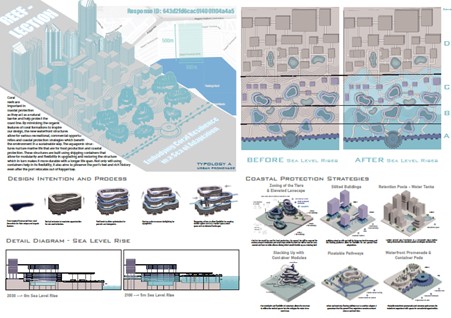
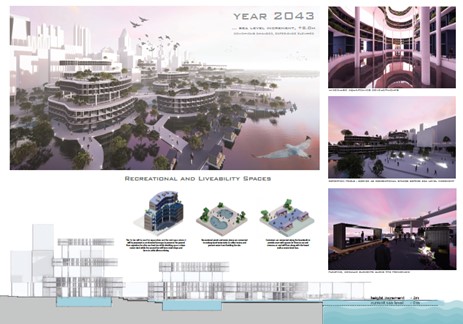
Woven Hill at Marina South
By Muhamad Hazim Bin Ab Wahab, Siendy Natanael Ang
Nanyang Academy of Fine Arts (NAFA)
Woven Hill seeks to establish a seamless connection among humanity, nature, and water, while also addressing the imminent challenge of rising sea levels by creating 3 zones - Ecological Introduction, Community Commons, and Blue Oasis. The park is designed to create an environment that allows visitors to feel fully immersed in their surroundings and actively participate in the experience through diverse planting palettes and zones.
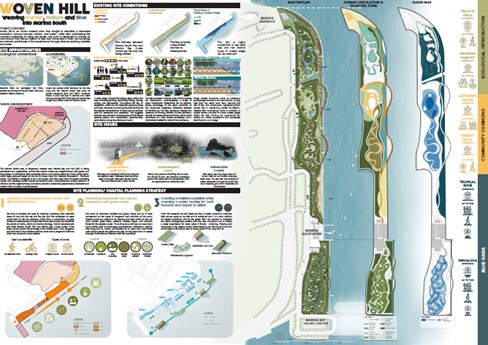

2. Typology B: Nature-Centred Coastline
InterCoast at Labrador Park
By Dones Franz Laurence Reyes, Jason Gao Jian Cheng
Nanyang Academy of Fine Arts (NAFA)
The meaning behind InterCoast signifies the connection between the users, the ecosystem, and ocean waters. InterCoast utilises adaptable and regenerative measures integrated through urban biophilic design to ensure the safety of both the users and ecosystems from sea level rise while promoting a sustainable and liveable coastline.
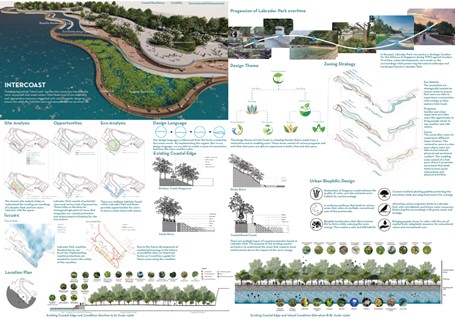
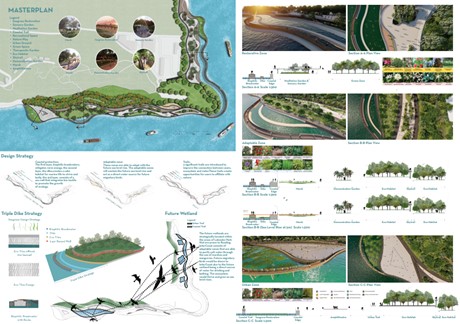
Meander at Labrador Park
By Arista Theodora Victoria Suiwito, Wong Yun Ting, Yang ShouDong
Nanyang Academy of Fine Arts (NAFA)
Meander aims to immerse users in interactive experiences using various coastal activities in designated recreational spaces. Bringing attention to the existing flora and fauna in the environment, these spaces establish strong green and blue connections by allowing users access to areas including eco ponds, swales, and rain gardens. Coastal protection measures are incorporated into the design to address the ongoing concerns of rising sea levels.
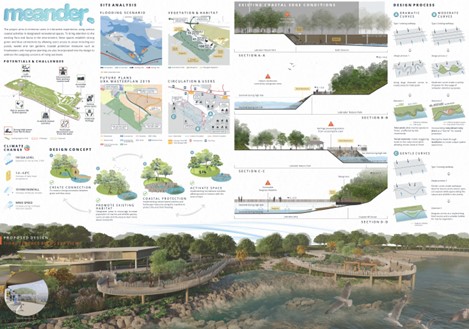
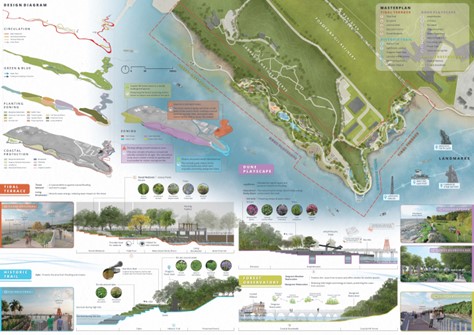
Trifoliate Horizon at Labrador Park and Berlayer Creek
By Chai Jin Xie, Tan Zhi Xian, Yeong Yoong Sze, Yew Jun Hao
Nanyang Technological University (NTU)
Trifoliate Horizon adopts innovative strategies to conserve our natural heritage and to expand our island-wide network of play corridors, parks, sports facilities, and green spaces, while protecting our coastlines. This creates more opportunities for residents to connect with nature and provide a variety of recreational experiences.
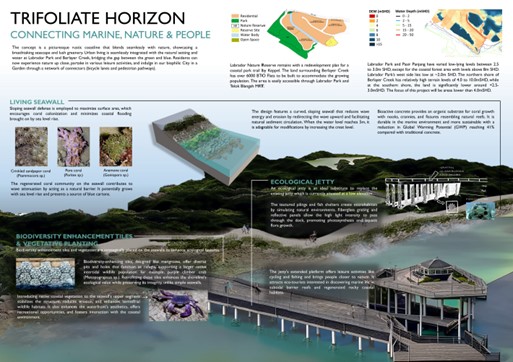
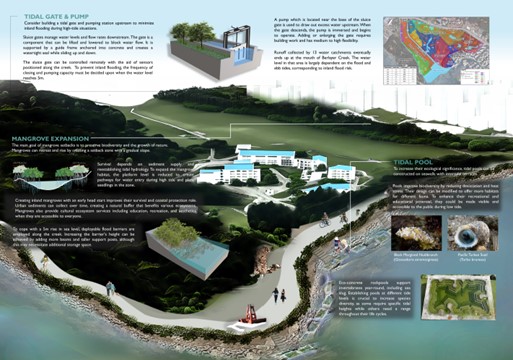
3. Typology C: Recreational Seafront
Emerald Coast at East Coast
By Chai Jin Xie, Tan Zhi Xian, Yeong Yoong Sze, Yew Jun Hao
Nanyang Technological University (NTU)
Emerald Coast consists of three islands that string Changi City to Founders Memorial. It concentrates diverse experiences for the people, weaving a tapestry of leisure, travel, heritage, business, luxury, education, retail, housing and greenery into the landscape. The name reflects the spirit of the design – combining hybrid engineering and human creativity, Emerald Coast gleams in the light of nature and shines in the vitality of human activity.
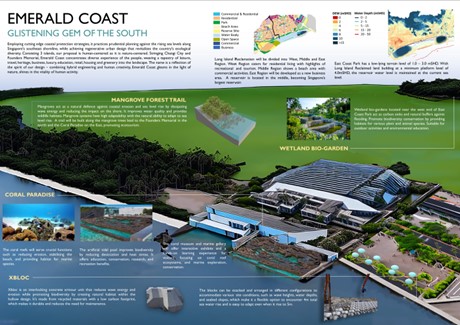
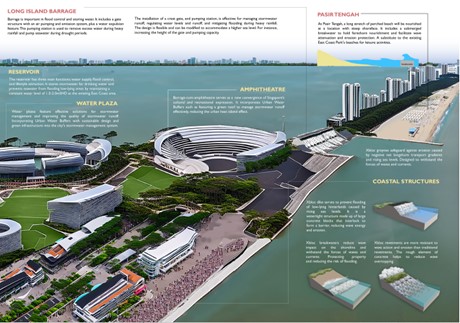
Endearing East Coast
By Crispus Tan Zhi Han, Cynthia Wee Su Yi, Dennis Yeo Tu Kai, Wang Yi Wen
National University of Singapore (NUS)
Combining engineering solutions together with nature-based solutions, Endearing East Coast envisions a recreation haven for the residents of Singapore, along a refreshed coastline lined with places that allow live, work and play. Above all, the strategies focus on enabling a self-sustaining system capable of adaptation, nurturing an integrated “Co-Habitat” for both human and non-human life, as well as safeguarding the unique coastal character of Katong, Marine Parade and Bedok, while enhancing waterfront accessibility in Marina East and Changi South.

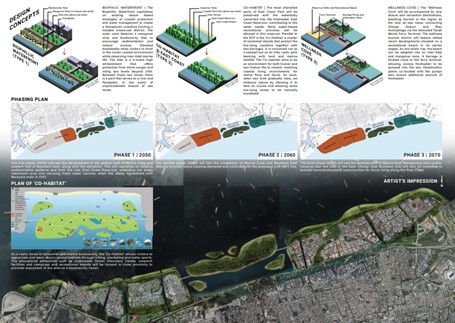
Island Chain at East Coast
By students from MSC Integrated Sustainable Design (Semesters 1 and 2 of 2022/2023) and MSC Sustainable and Green Finance (Jefferson and Zhao Jianxin – Class of 2023)
National University of Singapore (NUS)
Island Chain is a coastal defence strategy to protect the East Coast area of Singapore. This approach is anchored using hollow caisson sections to build the sea wall – a method that has been successfully implemented at the reclamation works at the Tuas Megaport project. The basements add vital capacity to the national space bank – particularly for critical uses like underground energy storage, water storage, sub-stations, food-storage, food farms etc.
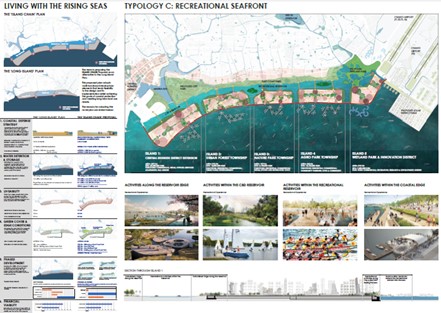
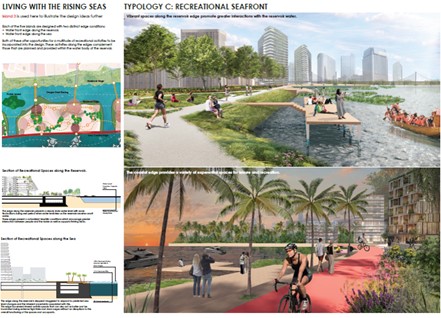
-End-